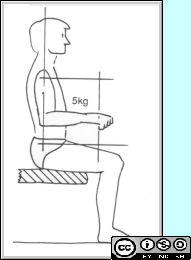
 |
| MODULE: INTRODUCTION TO ERGONOMICS |
 |
 |
 |
The figure on the right shows the basic numerical limits for lifting and lowering. These guideline weight limits can be applied
If the hands enter more than one of the box zones during the task, then the smallest weight limit should be used. Twisting: The handled weights should be lowered by about 10% if the handler twists by about 45 degrees and by 20% if he twists by 90 degrees. |
 |
 |
The figure on the left shows the seating weight limit Handling must be done with the boxed zone |
Whether the load is slid, rolled or on wheels, the maximum force for starting or stopping is 25 kg and the maximum force for keeping the load in motions is 10 kg. Note from GRD: Force is not measured in kg, but in newtons (N). The values would then depend on the acceleration the user imparts to the load. Comments ?
